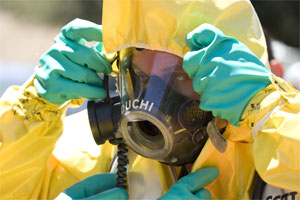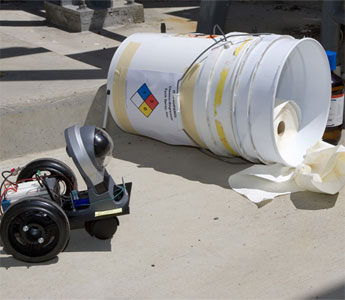Project ResCUE: Disasters Drive Call to Action
|
Oct. 16, 2006 -- September 11 and Hurricane Katrina are universally recognized as recent history’s most deadly U.S. disasters.
The details differ dramatically, but the events share an important distinction: experts agree that communication systems failed miserably, increasing the death toll and level of destruction.
Calit2 researchers at UC Irvine and UC San Diego are working to ensure that this type of failure never reoccurs. They are collaborating on a National Science Foundation-funded project called ResCUE – Responding to Crises and Unexpected Events – in conjunction with a host of subcontractors and partners, to design reliable, scalable infrastructures that can access, share and disseminate critical information to first responders in a timely manner.
“If we can get the right information to the right people at the right time, it will result in a faster, better response,” says ResCUE Director Sharad Mehrotra, UCI professor of computer science. “Lives and property will be saved, additional damage will be prevented and catastrophe may be avoided.”
Developing Effective Tools
ResCUE, a massive, five-year, $12.5 million project administered by Calit2, encompasses five other university partners as well as ImageCat, a Southern California company. The project also involves several city and first-responder organizations, and a dozen or more corporate partners. The collaborative, multidisciplinary venture, now in its fourth year, brings together computer scientists, engineers, social scientists and disaster science experts to explore technological innovations that will radically transform information flow in crisis response networks.
|
||||
The team’s effort is three-pronged. Researchers study the ways in which organizations and individuals respond in emergency situations, design technology to improve emergency response and test that technology in four increasingly sophisticated test beds.
Social science is a key research component, helping researchers understand what technology will work most effectively in which situations. “You can’t design technology in isolation,” says Carter Butts, UCI assistant professor of sociology. “Understanding human behavior – and the factors that allow humans to organize in adverse circumstances – is essential to improving the response process.”
Actual products – researchers call them system artifacts – are under development. These tools, ranging from wearable tracking devices to remote-controlled sensing platforms to customized communication software, can help emergency responders gather, analyze and disseminate essential information.
“Artifacts are (the place) where the rubber hits the road,” says Mehrotra. “We’ve worked very closely with first-responder partners to meet their specific needs.”
Degrees of Disaster Management
Emergency communications encompass a wide range of action. More than just the contact between first-responders and their emergency operations centers during a crisis, the term also refers to the process of gathering relevant data and conveying it concisely to crisis managers in order to improve their decision-making ability.
“When you design technology for a crisis site, your goal is to get just the basic, necessary information to the responder, because he doesn’t have time to think, he just has time to act,” says Mehrotra. “The further out you get in crisis management, the more important the bigger picture becomes. You’re trying to make sense out of very large amounts of information that are coming from multiple sources.
"We design technologies to help first responders assist victims, but we also design technology that can help decision-makers manage the crisis better. For the most effective emergency response, both are critical.”
Technology to Aid the Public
Researchers are also developing new avenues for transmitting critical information to citizens – information that may help them evacuate safely and stay apprised of essential updates after the event.
For example, the ResCUE team is developing a warning alert system that will send customized earthquake alerts to organizations and individuals seconds after an earthquake begins. Because seismologists have developed the ability to provide tens of seconds of warning before the shaking has extended a significant distance from an earthquake’s epicenter, the warning system can alert schools in the area, potentially saving thousands of lives. It can also keep parents informed about actions taken by schools, such as evacuation and medical triaging. The real-time alert system can also be used in other emergencies that have very short warning periods, like tsunamis and forest fires.
“We’re looking at what can be done to encourage citizens to take appropriate actions – not over-respond or under-respond,” says Nalini Venkatasubramanian, associate professor of computer science and a ResCUE researcher. This technology is being developed with input from the Natural Hazards Center , the California Office of Emergency Services, the Los Angeles Department of Emergency Preparedness and SBC, a company specializing in school-based communications.
Other natural disasters, such as hurricanes, floods and tornadoes, have longer warning periods. For these disasters, researchers are developing site-specific Web-based emergency information portals that will integrate various sources of information. “By using customized emergency management software, these portals can bring timely information in the days before and after a crisis to citizens and responders,” says Venkatasubramanian.
A prototype is being developed by ResCUE researchers for the City of Ontario, Calif., in collaboration with the city’s fire department. In the event of fire, flood, chemical spill or other disaster, the Emergency Information Portal will make available essential information: emergency shelters, evacuation routes, crisis control updates and links for locating missing relatives.
City of Ontario Fire Department Emergency Manager Jacob Green says, “The portal will allow our city to communicate vital information instantaneously to all members of the community. The partnership between the city and the university represents a collaborative effort to ensure that the citizens of Ontario are provided with the highest level of public safety and disaster preparedness.”
ResCUE researchers not only design new technologies, they assess their effectiveness in a number of test beds. A recent drill at UCI, coordinated by the campus’s environmental health and safety department, incorporated a variety of ResCUE technologies. First responders from the Orange County Fire Authority and the County of Orange Health Care Agency , as well as UCI building inspectors, police officers and employee emergency response teams participated in the exercise.
Community Advisory Board Created
Researchers have made significant progress in meeting the project’s ambitious goals. In order to keep the momentum, an advisory board, comprised of prominent members of the emergency response community, is an important part of the effort. The Community Advisory Board advises and guides RESCUE researchers with specific applications of information technology from the perspective of the first responder and the larger emergency management community.
The CAB is chaired by Ellis Stanley, general manager of the Los Angeles Department of Emergency Preparedness.
ResCUE strives to incorporate its research findings into working prototypes, and then test the new technology to determine its role in facilitating emergency communication.
History has proven that – beginning in the moments before many disasters, through evacuation and rescue procedures, and into the long hours afterwards – effective crisis communication is vital in the effort to save lives and property. “The idea is to stay one step ahead of the crisis,” Mehrotra summarizes. “Technology has to get smarter about how it utilizes itself for maximum impact.”



